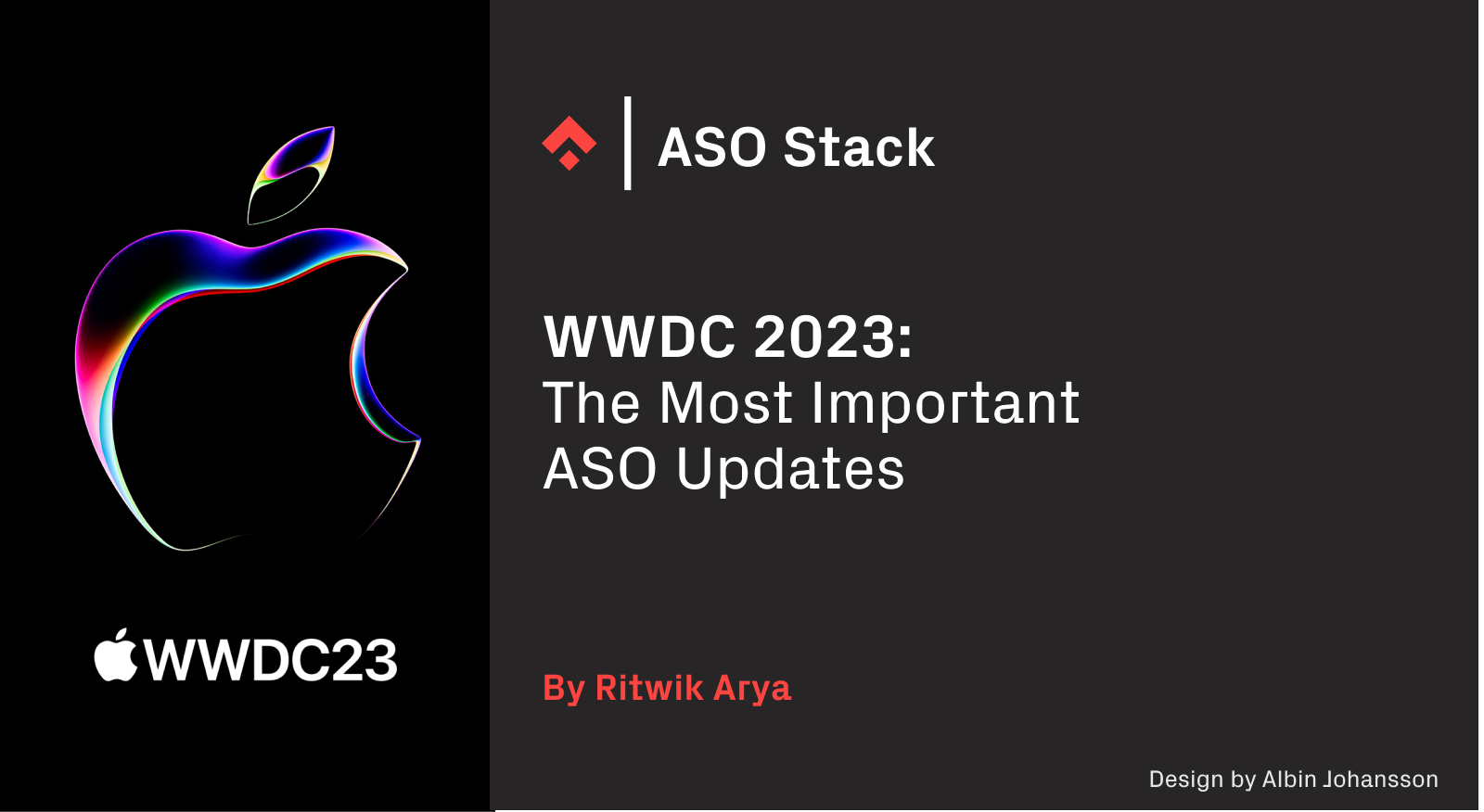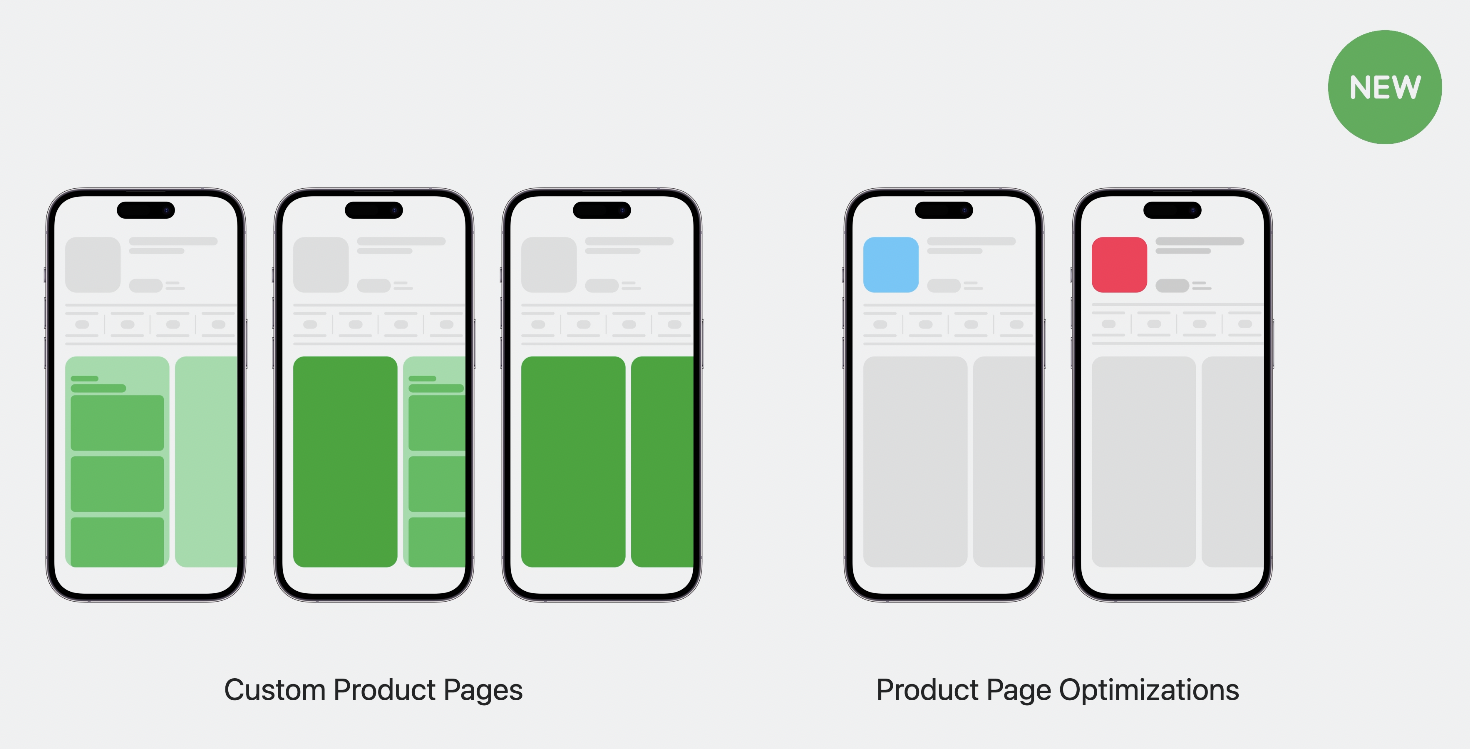
The eagerly anticipated 2023 Apple’s Worldwide Developers Conference (WWDC) certainly lived up to the hype this time around, with the Vision Pro and a whole host of new features for iOS17 on their way. Away from the bigger news stories from Apple Park, there was plenty to take in from an ASO perspective too, from new App Store Connect capabilities (including for the Vision Pro), to enhanced privacy measures. ASO is often relates to ensuring marginal gains, so staying abreast of such updates is vital for ASO practitioners. Here, we summarize the mostly noteworthy ASO updates from WWDC 2023.
Run PPO with app updates
App Store Connect has been updated so that ASO practitioners now have the ability to conduct Product Page Optimization (PPO) tests even after submitting a new app version. Previously, this was not possible, leading to a reluctance among many to engage in PPO experiments with some resorting to using Custom Product Pages for gaining insights for screenshot experimentation. Thanks to this new update, we anticipate a significant increase in the popularity of the PPO feature with ASO practitioners.
Bear in mind that making any changes to the baseline assets in any new app version updates will affect the PPO experiments, as the treatments are compared against the baseline. Therefore, if App Practitioners update the screenshots of the baseline while a PPO test is in progress, it will skew the KPIs and influence the outcome of the experiment.

A comparison of conversion rates from a PPO
App Store Connect for spatial computing (Vision Pro)
Apple unveiled the Vision Pro AR headset powered by xrOS, which now supports native apps and enables the usage of iPad and iPhone apps on the device. During a dedicated session, Apple unveiled updates to App Store Connect, specifically designed to manage Vision Pro. These updates include instructions on creating new apps for xrOS, guidelines on adding iPhone and iPad compatibility to xrOS, and methods for managing app compatibility on xrOS. During the session, Apple emphasized that app developers will experience increased downloads from Vision Pro headset users following the public release of these devices, representing a new opportunity.

The app creation process for xrOS
The good news for ASO practitioners is that App Store Connect will offer comprehensive analytics and all other App Store Connect features for Vision Pro, just like it does for other platforms like iPhone, iPad, and Mac. Meanwhile an additional feature named “Privacy Nutrition Labels” has been introduced specifically to address privacy concerns related to the Vision Pro.
Privacy Nutrition Labels will enable developers to disclose various types of data collection associated with the Vision Pro, including environment scanning, hand and head movement, eye tracking, and more. Since using the Vision Pro in a personal setting could potentially expose a significant amount of personal information to apps, these labels empower users to make informed decisions about which apps they choose to download, taking into account the disclosed user data collection practices.
A preview of the Privacy Nutrition Labels data collection settings
Enhancements to App Clips
Apple has announced that App Clips will increase the size limit for digital invocation to 50 MB. The change was implemented with the understanding that many users now have access to high-speed internet, and loading a 50 MB data package would not have a negative impact on the App Clip experience.
App Clips can be accessed through various means such as links in messages, QR codes, or the smart app banner on your website. With the expanded size limit, developers will have the opportunity to provide users from different referral traffic sources with a more immersive and enhanced experience.
However, it is worth noting that the size limit for physical invocation, such as NFC tags or App Clip codes, remains unchanged at 15 MB, as it was in iOS 16. Additionally, iOS 15 users will not be able to access App Clips larger than 10 MB.
Another exciting feature introduced under the App Clip umbrella is the ability to launch App Clips from links within an app. This empowers developers to enable cross-app usage, especially if they have multiple apps within the same developer account, creating opportunities for cross-selling and promotional activities.
Changes to App Store pricing
The pricing of an app can significantly influence users’ decision to download and pay for it, as it is prominently displayed on the app’s product page. Apple had previously announced the availability of 900 price points for developers to choose from. Further details regarding this change were provided during WWDC sessions.
By default, developers will have access to 800 price points. However, upon making a request to Apple, this number can be increased by an additional 100 points. These price points will be applicable in 44 currencies and across 175 regions.
Apple also explained the concept of setting a base region for a base price. To illustrate this, let’s consider an example where the United States is selected as the base region, and a base price is assigned to it. The App Store will then utilize this base price to generate equivalent prices for other global regions, taking into account exchange rates and specific taxes. These global prices will automatically adjust as foreign exchange rates and tax rates fluctuate, ensuring consistency with the base price.
Moreover, developers have the flexibility to schedule base price changes for future dates, review comparable global prices, and confirm them. Temporary prices can also be set, allowing for scheduled price changes within a specific time duration. During this period, global market prices will not be automatically adjusted.
Some apps may be excluded from this feature, because if your app is free or free to download but includes in-app purchases or subscriptions (like a free trial followed by a subscription), you would ordinarily set the app’s price to “0” in App Store Connect, therefore not requiring you to set the pricing here.
Changes to App Store pre-orders
With the enhanced Pre-Orders feature, developers now have the ability to offer their app for pre-order in certain regions while simultaneously soft-launching it in other regions. App Store Connect provides an “Availability” page where you can view a summary of the app’s download availability, pre-order availability, and regions where it is not available. While you have the option to launch the app prior to its official release date, once you make it available for download, you cannot revert to offering it for pre-order again.
 A representation of the pre-order feature, with regional differences in availability
A representation of the pre-order feature, with regional differences in availability
Custom Product Page (CPP) and Product Page Optimizations (PPO) available for pre-order apps
An exciting announcement for ASO practitioners is the introduction of the ability to build Custom Product Pages (CPP) and Product Page Optimizations (PPO) for pre-order apps. The performance of these metrics can now be tracked within app analytics. This empowers ASO practitioners to experiment with their product page even before the app is officially launched, allowing them to optimize their assets and metadata well in advance for a successful app launch.
CPPs and PPOs now available for pre-order apps
New privacy updates for iOS
Apple has announced new privacy changes aimed at further safeguarding iOS users. You can find a detailed explanation of all the changes here. Below are some of the key announcements:
- Photo picker: Apps can now request access to specific photos or videos without requiring permission to access the entire photo library. This provides users with more control over the data they share with apps.
- Write-only calendar access: To address privacy concerns, users may hesitate to grant access to their calendar, preventing apps from adding events. To overcome this, developers can utilize EventKitUI to write events to a calendar without explicitly seeking calendar access. Alternatively, apps can prompt users to grant write-only permissions for calendar access.
- Communication safety: Developers now have the ability to detect sensitive content using on-device processing and provide warnings to users. This feature is supported in apps such as Messages, AirDrop, FaceTime, Phone, and Photos.

The chief areas of new privacy changes with iOS 17
Before you go
- During WWDC 2023, Apple also announced the winners and finalists of the Apple Design Awards. These awards were given to apps across various categories, such as inclusivity, delight and fun, interaction, social impact, and more. ASO practitioners are encouraged to visit the product pages of the winning and finalist apps to gain insights into how these apps excel compared to their competitors, and to discover valuable lessons that can be applied to their own ASO strategies.
- WWDC 2023 had a number of highlights relevant to mobile growth as a whole. You can find our full report here.
- Google I/O 2023 was also an action-packed event, the centerpiece of which was the numerous advancements in AI technology Google unveiled, that will change the day-to-day work of ASO practitioners. There were plenty of other updates too, and, in this recap, we take you over the most important news from Mountainview for ASO practitioners, and offer up our own analysis.




















